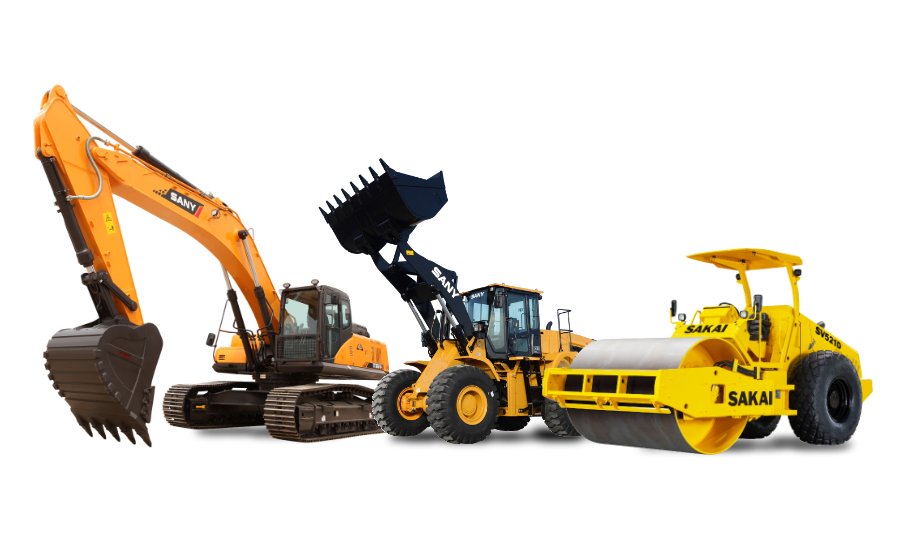Heavy Equipment Rental: High-Quality Machinery for Rental Fee
Heavy Equipment Rental: High-Quality Machinery for Rental Fee
Blog Article
A Comprehensive Overview to Heavy Tools Used in the Building Sector
In the world of building and construction, the utilization of hefty equipment stands as a cornerstone for efficiency and efficiency. From towering cranes to earth-shaking excavators, each item offers a crucial objective in forming the physical landscape around us. Comprehending the nuances of these machines, their functions, and the calculated factors to consider behind their choice can suggest the distinction between a project's success and failure. As we start this exploration of the thorough guide to hefty devices used in the building sector, we will explore the details that control their procedure, upkeep, and the advancing landscape of technological developments that continue to redefine the limits of construction capacities.
Sorts Of Heavy Tools
Within the building industry, a diverse series of heavy equipment is utilized to effectively execute numerous tasks. Excavators are one of the most frequently utilized sorts of heavy tools. These flexible machines are outfitted with an arm, taxicab, and pail mounted on a revolving system, enabling excavating and moving products with precision. Excavators, with their wide tracks and enormous blade in the front, are essential for jobs such as grading, clearing, and pushing hefty materials. Cranes play a vital role in training and relocating heavy materials on building and construction sites. Tower cranes are frequently made use of for tall structures, while mobile cranes are functional and can be easily delivered to different places. In addition, dump trucks are crucial for delivering products such as sand, gravel, and particles around building sites. Their capacity to carry hefty loads makes them vital for keeping a smooth workflow. Each kind of hefty tools plays a vital function in guaranteeing that building tasks are finished efficiently and efficiently.
Applications and functions
One of the crucial facets in recognizing the effectiveness of heavy equipment within the construction sector is analyzing their details features and applications. These makers are created to do a selection of tasks that are necessary for building and construction jobs of all dimensions. Excavators, for instance, are generally used for excavating trenches, openings, and structures, while bulldozers stand out in clearing up and grading land. Cranes are vital for lifting and moving hefty products on building sites, and discard trucks are crucial for transferring products like sand, dirt, and gravel. Additionally, loaders are versatile makers that can take care of tasks such as material handling, excavation, and grading.
The applications of heavy tools prolong beyond traditional building jobs. As an example, compact track loaders are excellent for working in rough terrains, making them suitable for landscaping and farming jobs. Skid guide loaders are generally used for tasks needing ability to move in limited spaces, such as interior building or demolition jobs. Recognizing the features and applications of hefty equipment is crucial for utilizing these devices effectively in various construction scenarios.
Considerations for Equipment Selection
When picking heavy equipment for building and construction jobs, cautious consideration of numerous variables is crucial to guarantee optimum performance and efficiency. Comprehending the scope, dimension, and intricacy of the construction task will assist figure out the type and dimension of devices needed. boom lift rental. By carefully evaluating these considerations, building and construction business can choose the ideal heavy equipment for their tasks, leading to effective end results.
Upkeep and Security Practices
Executing strict maintenance and safety and security methods is critical in the construction market to guarantee the durability of heavy equipment and the protection of workers. Regular upkeep routines must be established and abided by for all heavy equipment. This includes routine examinations, lubrication, and substitute of worn components to avoid malfunctions and make sure optimal performance. Correct training for tools drivers is important to lessen the danger of crashes. Operators needs to be well-versed in the secure usage of each machine, consisting of comprehending its limitations and capacities.
Security protocols need to be purely imposed on construction sites to protect employees and avoid injuries. This consists of making use of individual protective tools, such as difficult hats, handwear covers, and steel-toed boots. Additionally, all employees should undergo routine security training to remain notified regarding prospective threats and appropriate emergency situation procedures. It is vital to perform complete pre-operational checks before utilizing any type of tools to validate that it is in great functioning problem. By prioritizing maintenance and safety methods, building and construction firms can promote a safe workplace and prolong the lifespan of their hefty equipment.

Arising Patterns in Building And Construction Tools
To stay in advance in the building and construction industry and adjust to progressing requirements, companies are increasingly turning in the direction of including innovative modern technologies and innovations in their heavy devices, showing the emerging fads in building and construction equipment. One noticeable fad is the assimilation of telematics systems in construction machinery. These systems permit real-time tracking of devices efficiency, location monitoring, and even anticipating maintenance, enhancing functional effectiveness and reducing downtime.
An additional significant fad is the increase of independent construction tools. From self-driving dump trucks to automated excavators, these devices are changing building construction equipment rentals websites by boosting accuracy, performance, and safety. Additionally, the use of drones for evaluating, mapping, and progress surveillance is coming to be more prevalent, offering valuable understandings and simplifying operations.
Furthermore, the building and construction sector is significantly checking out the use of 3D printing modern technology to create parts and even whole frameworks on-site, saving time and costs while making it possible for greater design versatility. As modern technology continues to development, these emerging patterns are positioned to form the future of construction equipment, driving development and performance throughout the sector.
Verdict
In final thought, heavy equipment plays an important function in the construction market by supplying the essential power and efficiency to complete different tasks. Comprehending the different kinds of equipment, their features, and applications is vital for choosing the right equipment for the job. Maintenance and security methods are important to guarantee the longevity of the equipment and the safety of employees. Staying on par with arising patterns in building equipment can help companies remain competitive in the industry.

Applying rigorous maintenance and security practices is extremely important in the construction market to ensure the longevity of heavy devices and the protection of workers.To remain in advance in the construction sector and adapt to evolving requirements, business are progressively turning in the direction of incorporating sophisticated modern technologies and innovations in their hefty tools, mirroring the arising patterns in building tools.In verdict, hefty tools plays an important role in the construction sector by giving the needed power and effectiveness to finish numerous jobs. Understanding the various kinds of devices, their functions, and applications is vital for choosing the best tools for the work.
Report this page